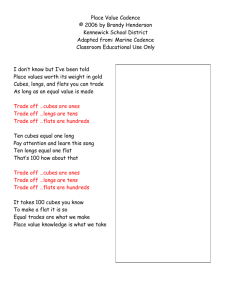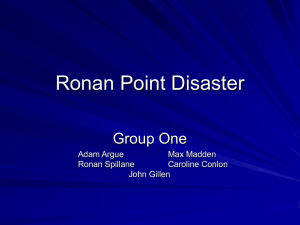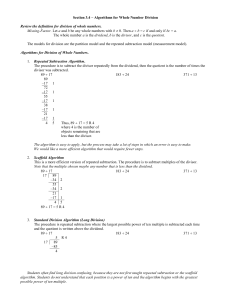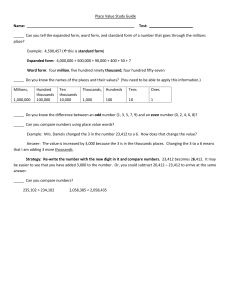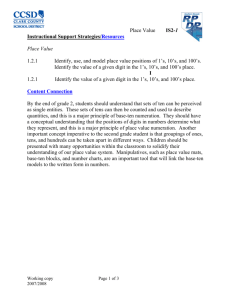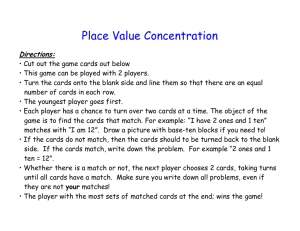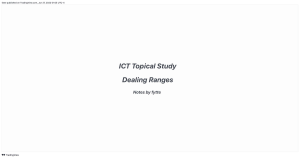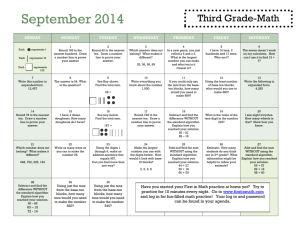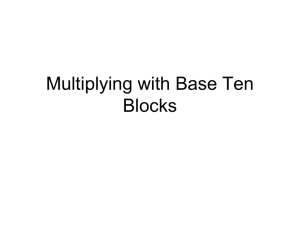Exam 2 Review Answers
advertisement
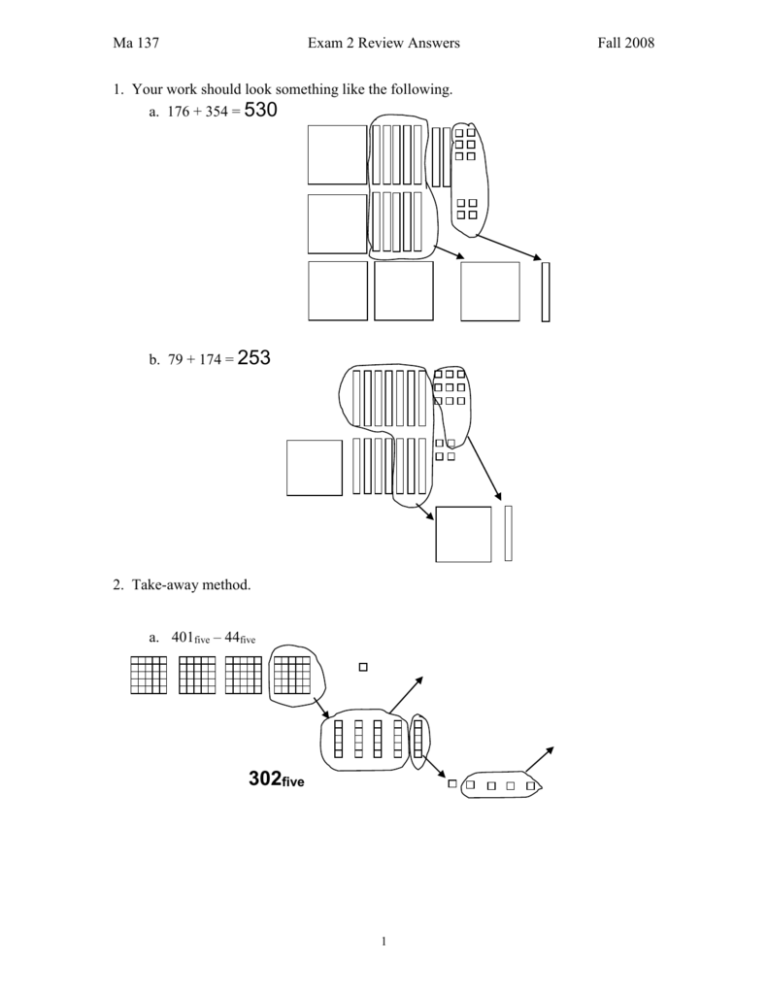
Ma 137 Exam 2 Review Answers 1. Your work should look something like the following. a. 176 + 354 = 530 b. 79 + 174 = 253 2. Take-away method. a. 401five – 44five 302five 1 Fall 2008 Ma 137 Exam 2 Review Answers Fall 2008 Comparison method b. 2112five – 244five 1313five 3. 975 + 238 1100 100 13 1213 4. Compute the product 243 37 using the partial products algorithm. 243 137 21 = 7 3 280 = 7 40 1400 = 7 200 90 = 30 3 1200 = 30 40 6000 = 30 200 8991 2 Ma 137 Exam 2 Review Answers Fall 2008 5. 1210four 6. Answers might vary to some extent. The following show one way to answer the question correctly. a. 47 + 18 = 50 + 15 = 65 (substitution) b. 128 – 15 + 27 – 50 = (128 – 50) + (27 – 15) = 78 + 12 = 90 (compatible #s) c. 83 + 50 – 13 + 24 = (83 – 13) + 50 + 24 = (70 + 50) + 24 = 120 + 24 = 144 (compatible #s) d. 23 + 25 + 28 = 25 + 25 + 26 = 50 + 26 = 76 (substitution) 7. The scale reads 873 kg, so the actual weight of brick is 873 – 83 = 790 kg. The order was for 914, so the load is short by 914 – 790 = 124 kg. 8. a. 7ten 8ten = 56ten (This is a basic fact, since we normally use base ten.) b. 3four 2four = 12four (3 2 = 6, but in base four, this should be 12four) c. 1nine 8nine = 8nine (1 is the identity under multiplication, no matter what the base.) d. 5six 5six = 41six (5 5 = 25, but in base six, this should be 41six) e. 2five 2five = 4five (2 2 = 4, even in base five.) 3 Ma 137 Exam 2 Review Answers Fall 2008 9. Make a diagram of the base-ten number piece rectangle representing each product. Write the product underneath the sketch. a. 23 13 299 b. 15 20 300 10. a. 14five 23five 2 flats 11 longs 12 units 432five b. 22four 22four 4 flats 8 longs 4 units 1210four c. 31eight 13eight 3 flats 10 longs 3 units 423eight 4 Ma 137 Exam 2 Review Answers a. 1 9 = 9 2 9 = 18 3 9 = 27 4 9 = 36 5 9 = 45 6 9 = 54 7 9 = 63 8 9 = 72 9 9 = 81 10 9 = 90 23 9 = 207 11. Fall 2008 1+8=9 2+7=9 3+6=9 4+5=9 5+4=9 6+3=9 7+2=9 8+1=9 9+0=9 2+0+7=9 b. In base six, the same pattern exits. Multiplying any base-six number by 5six yields a number whose digits sum to 5. In answering this question, you would need to show explicitly several examples to show that this does in fact work. For example, 23six 5six = 203six, and 2six + 3six = 5six. 12. a. 25 13 = 25 (10 + 3) = 250 + 75 = 325 (Note: the sum 250 + 75 could be made easier through substitution: 250 + 75 = 300 + 25.) b. 15 102 = 15 (100 + 2) = 1500 + 30 = 1530 c. 40 98 = 40 (100 – 2) = 4000 – 80 = 3920 d. 51 9 = 51 (10 – 1) = 510 – 51 = 500 – 41 = 459 OR 51 9 = (50 + 1) 9 = 450 + 9 = 459 (rather easier) 13. a. 16 4 = 8 8 = 64 b. 5 18 = 10 9 = 90 14. (Examples of sketches are given in earlier answers) a. 43five + 44five = 142five b. 2312four – 203four = 2103four 15. Anna is correct since 120 is one hundred two tens and no ones. Katie is correct since one hundred is equivalent to ten tens, so 120 has 10 + 2 = 12 tens. 16. a. 87 + 18 = 87 + (3 + 15) = (87 + 3) + 15 = 90 + 15 = 105. b. The associative property of addition. 5 Ma 137 17. Exam 2 Review Answers 9 8 1 4 2 1 + 1 4 0 2 18. So 452 ÷ 4 = 113 19. . Start with Arrange these pieces in a rectangular array that is one long and three units high. The resulting array is one long and 4 units wide, so the quotient is 14. 6 Fall 2008

